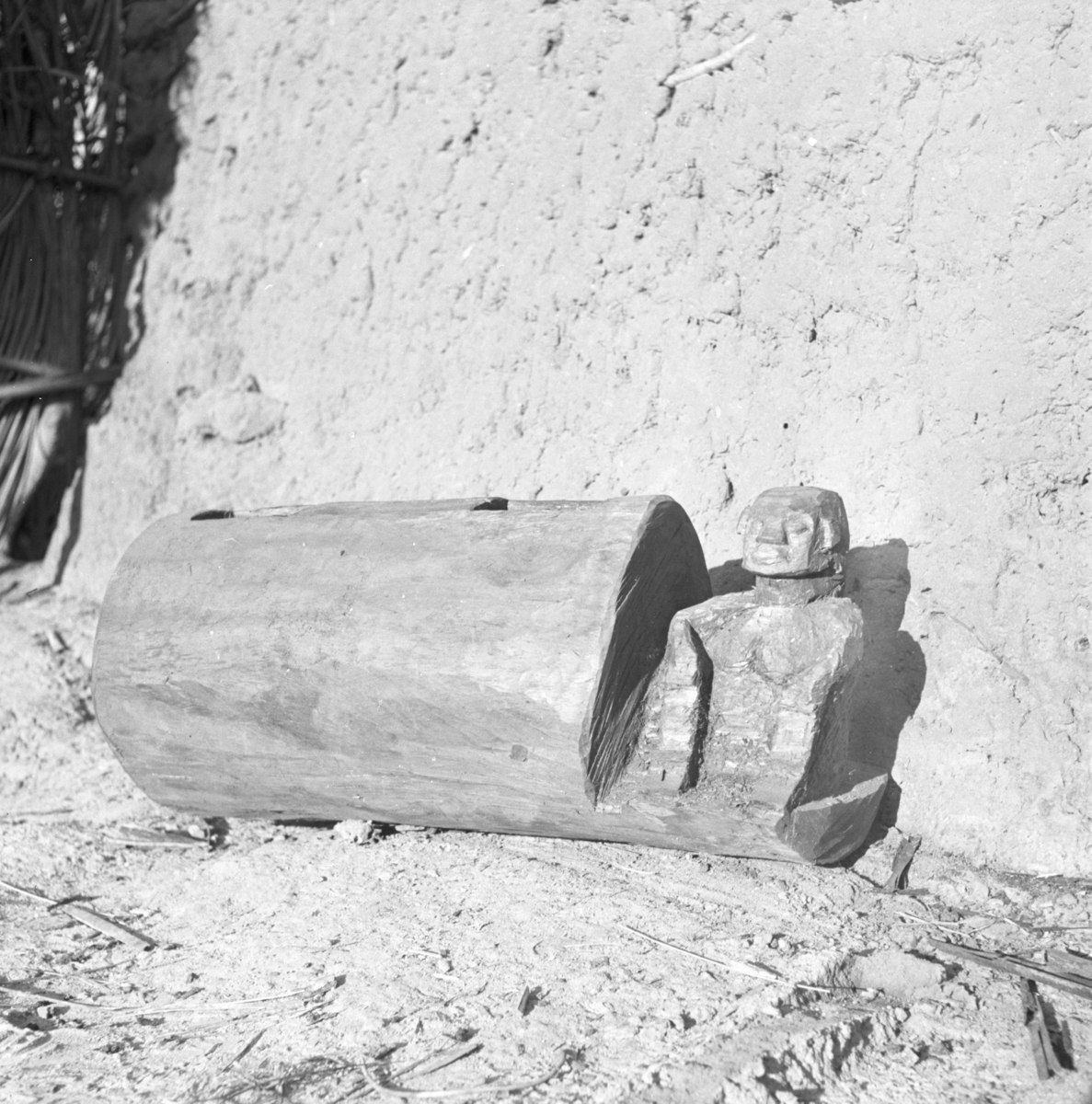
This end of an Ikoro (large slit drum) depicting a seated woman figure holding a baby in her lap. The face of the woman figure is stylized and consists of almond-shaped eyes beneath arched brows, a triangular-shaped nose, an incised mouth, and elliptical-shaped ears. The upper torso consists of large rounded shoulders, breasts, and bent arms with incised markings for fingers. One hand is placed underneath the baby’s head. The lower torso shows the seated position of bent legs and striated markings indicating toes. The baby’s face is similar in description to the mother’s, with arched brows, almond-shaped eyes, a triangular nose, and a mouth. One arm of the child is touching the abdomen next to the raised navel. The drum appears to be located inside a room or shrine made of raffia mats, wooden rafters, and purlins.
The Ikoro Drum
The Ikoro drum holds a special place in Igbo and Ibibio cultures. Known as “ikorok” in Ibibio, these large slit drums were used for communication over long distances. Their loud sound could summon people for war, festivals, or emergencies, making them central to community rituals.
Historical Context and Usage
Ikoro drums, carved from large logs, often feature detailed carvings. They are more than musical instruments; they symbolize cultural identity. The carvings of a woman and child on one end of the drum likely represent fertility and continuity. Some drums depict both male and female figures to symbolize balance and duality in the community.
G.I. Jones noted that some Ikoro drums, like this one, had figures on both ends, emphasizing gender roles in Igbo cosmology (Jones, 1984). These drums were usually kept in special structures, highlighting their importance.

This end of a large Ikoro drum depicting a carved wooden figure. The figure is a large seated man with a humanized face consisting of protruding eyes, a triangular-shaped nose, an open mouth, and elliptical-shaped ears. There is a carved square on the cheek, likely indicating scarification. The arm is bent with striation marks indicating fingers, and there is protruding male genitalia. The drum appears to be located in a room or shrine with raffia mats and bamboo poles for covering.
Craftsmanship and Symbolism in Ikoro Drums
Creating an Ikoro drum requires great skill and artistry. Carved from a single log, these drums feature intricate designs that reflect societal roles and beliefs. The carvings of the woman and child symbolize nurturing, while the male figure represents strength and protection.
These drums are storytellers, their carvings conveying deep meanings understood by the community. The Ikoro’s sound echoes cultural ethos and serves as a bridge between the physical and spiritual realms.
Another example from the Jones Archive illustrates the diversity in Ikoro drum carvings.

An Ikoro slit drum made from a log in which the two ends are intact but the center removed through a narrow longitudinal slit. At one end of the drum is a carved figure (from the same piece of wood) consisting of a head and upper torso. The carved head is flat on the top and consists of incised eyes, a wide nose, lips, and ears. The drum is perched against a wall—possibly dried earth or clay. In the left-hand side of the photograph is a basket and dried fronds.
This drum highlights another aspect of Igbo artistry, where the carved head and torso symbolize ancestral presence and community guardianship.
The Role of Ikoro in Igbo Societies
The Ikoro drum’s influence extends beyond music. It is central to social cohesion, communication, and cultural identity. Its sound could relay messages across distances, ensuring community connectivity. The drum also played a role in validating social hierarchies. Presenting a trophy head to the Ikoro was a mark of bravery and success.
Ikoro drums were often housed in dedicated structures, signifying their importance. These structures, sometimes shrines, protected and honored the drums. The communal aspect of the Ikoro fostered unity. During festivals, the Ikoro’s sound gathered people, promoting social cohesion and cultural participation.
Preserving the Legacy
Preserving Ikoro drums is vital for understanding Igbo heritage. These artifacts offer insights into traditional practices, artistic expressions, and social structures. Documenting and studying these cultural treasures is crucial to maintaining the legacy and cultural identity of the Igbo people.
Today, the Ikoro drum continues to inspire artists and cultural practitioners. Its legacy lives on in music, dance, and visual arts. Contemporary Igbo and Ibibio artists draw on Ikoro imagery and themes to explore identity, heritage, and social change.
How do you think traditional instruments like the Ikoro drum influence contemporary Igbo music and cultural practices? Share your thoughts and join the discussion in the comments below.
Explore Further
For more on this topic, explore our recommended readings below. Each provides deeper insights and a broader perspective.
 Recommended Books
Recommended BooksTitle: Igbo Arts: Community and CosmosAuthors: Herbert M. Cole, Chike G. AniakorForeword: Chinua AchebePublisher: Univ of California Museum of Cultural HistoryPublication Date: January 1, 1984Format: Paperback, 238 pagesISBN: 978-0930741013 Overview “Igbo Arts: Community and Cosmos” by Herbert M. Cole and Chike G. Aniakor is a comprehensive examination of Igbo art, culture, and community life. With […]
 Recommended Books
Recommended BooksTitle: Art of Eastern NigeriaAuthor: Gwilliam I. JonesPublisher: Cambridge University PressPublication Date: August 31, 1984Format: HardcoverPages: 240ISBN-10: 0521259274ISBN-13: 978-0521259279Language: English Overview “Art of Eastern Nigeria” by Gwilliam I. Jones is a significant work that explores the rich artistic traditions of Eastern Nigeria. This book provides a comprehensive analysis of the region’s art forms, examining their cultural, historical, and social contexts. About the Author Gwilliam […]
Discover more from Igbo Archives
Subscribe to get the latest posts sent to your email.




